Generative AI in Healthcare: A Gateway to Intelligent Medicine
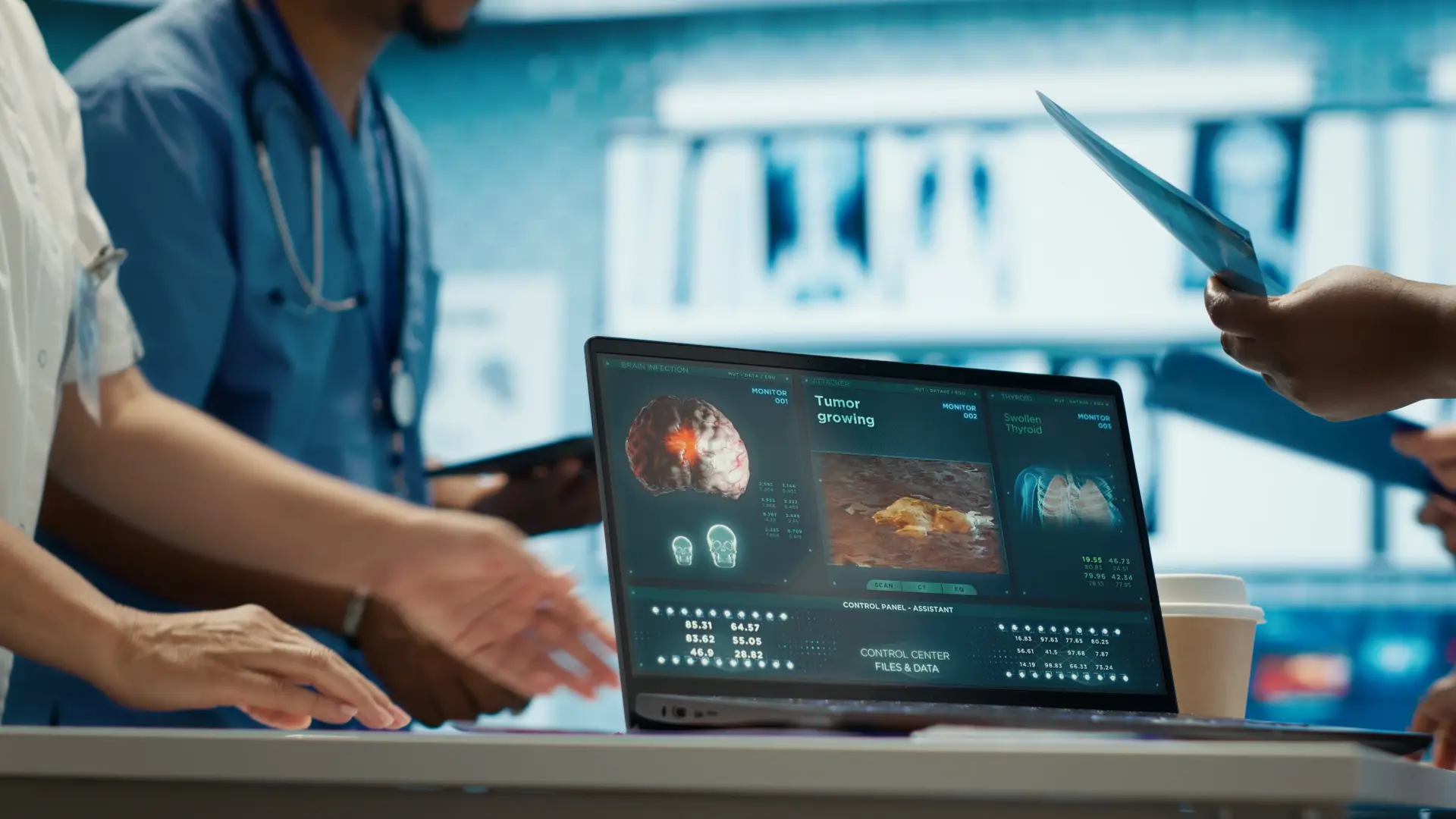
Unlocking $1 trillion in improvements – this is the promise of generative AI in healthcare industry. Quite ambitious, wouldn’t you say? GenAI appears ready to change the way healthcare is provided and perceived.
Initially, AI in healthcare focused on predictive analytics and operating room scheduling. Modern AI development services, however, have expanded their applications. Generative AI now automates repetitive tasks, gives clinicians instant access to vast amounts of clinical data, and updates health system infrastructure.
The vast potential of generative AI hasn’t gone unnoticed by healthcare organizations. Precedence Research reports that the global market of generative AI in healthcare hit $1.45 billion in 2023 and could exceed $21.74 billion by 2032. With a CAGR of 35.14% from 2023 to 2032, the interest and investment in this technology are substantial.
Already heard about generative AI yet but want to know more? In our guide, we’ve tried to cover all the advantages generative AI can bring to healthcare. Might be worth checking out!
What is Generative AI: The Basics
Generative AI is a type of artificial intelligence that produces new content or data mirroring the traits of existing data. Unlike earlier AI models that were limited to analysis and interpretation, Generative AI can create new content based on learned patterns, summarize and translate information, and even “reason and plan.” This capability became possible with the help of technologies such as:
- Deep Learning (DL): This involves advanced neural networks that capture and model intricate patterns and relationships within data, enabling sophisticated analysis and prediction capabilities.
- Reinforcement Learning: This area focuses on algorithms that learn to make decisions by receiving feedback from their actions optimizing behavior through a trial-and-error approach.
- Natural Language Processing (NLP): NLP includes a set of techniques that allow machines to understand and create human language, enabling functions like translation, sentiment analysis, and interactive dialogue systems.
- Generative Adversarial Networks (GANs): In these systems, two neural networks work against each other to enhance the quality of the content they generate, one creating content and the other evaluating its authenticity.
- Transformer Models: These architectures, like GPT-3, are designed for superior language understanding and generation, making them effective for a wide range of natural language tasks.
- Autoencoders: These neural networks are designed to learn efficient representations of data, enabling tasks such as data compression, noise reduction, and generation of new data that resembles the input.
- Variational Autoencoders (VAEs): These models specialize in generating new data by learning the underlying distributions of the input data, allowing for the creation of diverse and realistic outputs.
- Transfer Learning: This technique involves taking a model pre-trained on one task and adapting it to perform a different but related task, often with less data required for the new task.
- Self-Supervised Learning: In this approach, models are trained to generate and utilize data with only partial information, which helps create robust representations without needing extensive labeled datasets.
- Cloud Computing: This technology provides the necessary computational power and storage to train large-scale AI models, enabling the efficient handling of extensive data and complex calculations.
When used proactively, Generative AI can enhance many areas of healthcare. It improves continuity of care, streamlines clinical operations, and supports corporate functions like purchasing and accounts payable.
On the clinical side, GenAI has the potential to create discharge summaries, highlight important clinical details, translate instructions into various languages, compile lab summaries from doctor rounds, and synthesize shift hand-off notes. It can advance EHR functionality by pre-completing visit summaries and advising on documentation adjustments.
Generative AI Technology Evolution
Generative AI has come a long way, with several improvements that impact various technological fields, including healthcare. Here’s a detailed exploration of its evolution:
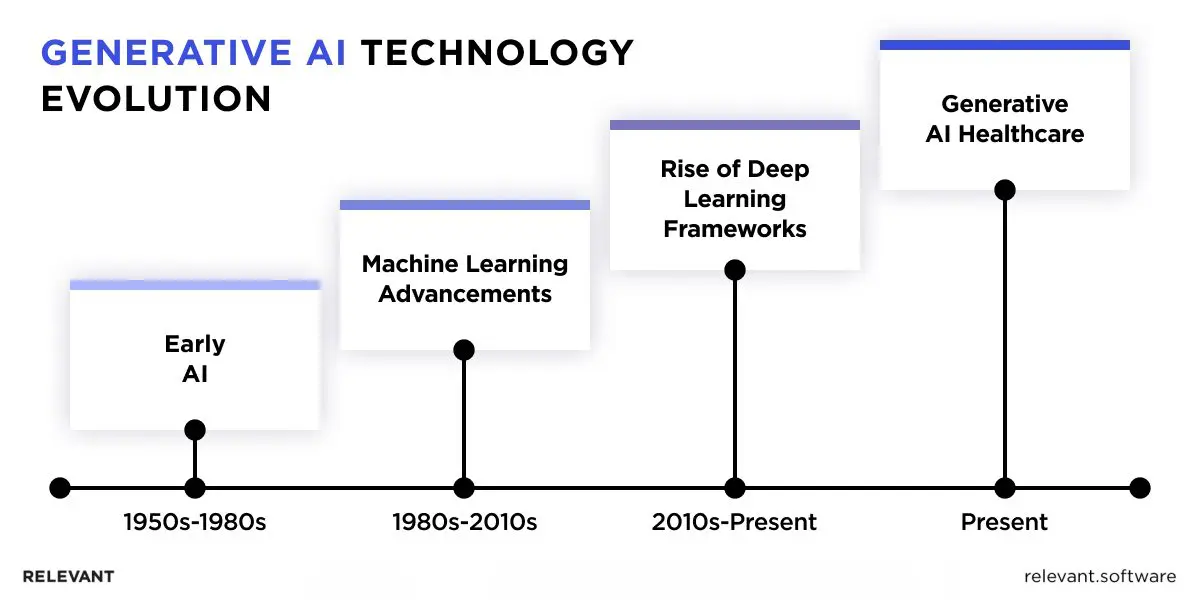
Early AI (1950s-1980s): Generative AI began with early research on rule-based systems and statistical methods. Back then, pioneering work in AI introduced algorithms capable of simple decision-making and pattern recognition. These initial efforts gave us the first neural networks and the basics of machine learning, setting the stage for everything that followed.
Machine Learning Advancements (1980s-2010s): The late 20th century and early 21st century marked a period of rapid advancements in machine learning. Neural networks and backpropagation algorithms, introduced in the 1980s, equipped AI systems with data learning capabilities. By the 2000s, deep learning algorithms took it to the next level. The multi-layered neural networks in DL helped AI recognize and interpret complex patterns in vast datasets, setting the stage for more sophisticated generative models.
Rise of Deep Learning Frameworks (2010s-present): A pivotal moment for generative AI came in the 2010s with the rise of deep learning frameworks, particularly the 2014 introduction of Generative Adversarial Networks by Ian Goodfellow and his team. Further, open-source frameworks like TensorFlow and PyTorch made generative AI more accessible to the research and development community.
Generative AI Healthcare (present): In recent years, generative AI models like DALL-E 2, GLIDE, and ChatGPT generate synthetic datasets that protect patient privacy, design novel drug compounds, and personalizes treatment regimens based on individual genetic profiles. They are also used to create realistic virtual patients and scenarios, preparing healthcare professionals for real-world clinical challenges, which leads to better patient care.
Generative AI algorithms rapidly advance. According to Robert Pearl of Stanford University, “ChatGPT doubles in power every six months to a year. Its power will be 30 times greater in five years, and in 10 years, it will be 1,000 times greater. Today’s AI will appear rudimentary in comparison.” Anticipated future AI in healthcare are tools that will likely possess a trillion parameters comparable to the brain’s connections.
Your next read – How to create an AI
The Real Benefits of Generative AI in Healthcare
Generative AI enhances diagnostic accuracy and efficiency, cuts costs, improves patient outcomes and extends healthcare services to more people. Let’s look in more detail on these benefits of AI in healthcare.
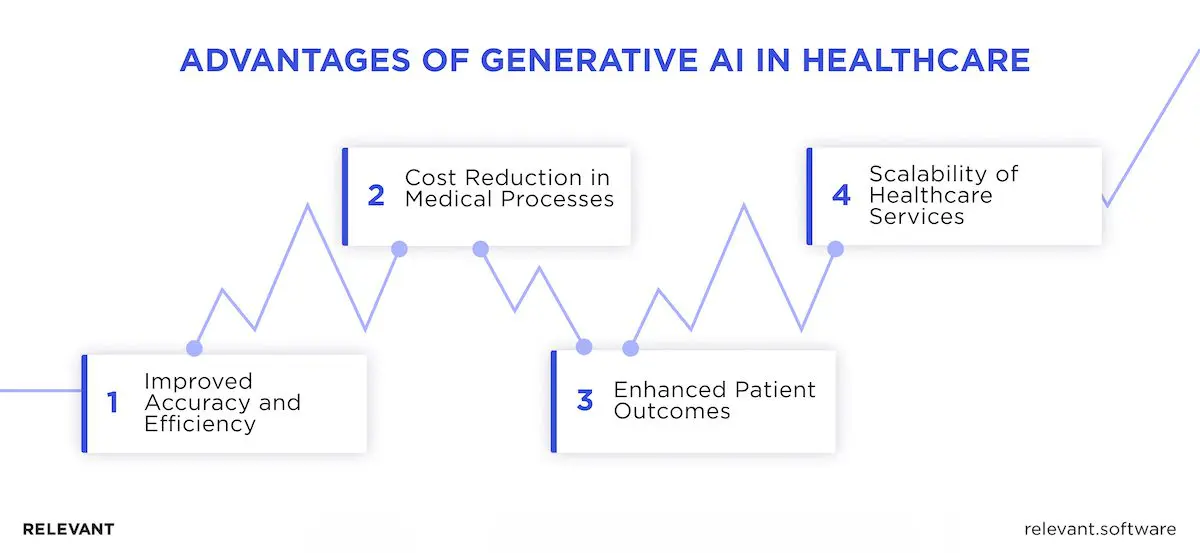
Improved Accuracy and Efficiency
Generative AI use cases in healthcare have enhanced the precision and efficiency of various medical and administrative processes. AI-driven diagnostic tools, for example, can analyze medical images with a precision that rivals experienced radiologists.
According to a Nature study, AI algorithms detected breast cancer from mammograms with over 94% accuracy, surpassing the 88% accuracy rate of human radiologists. This remarkable accuracy leads to early and accurate diagnosis and reduces the likelihood of unnecessary procedures and follow-ups.
Additionally, AI perfectly streamlines boring administrative tasks, such as patient data management and appointment scheduling. That reduces human error and frees healthcare professionals to focus on patient care. Hospitals utilizing AI for these purposes have reported a 30% increase in operational efficiency.
Cost Reduction in Medical Processes
A McKinsey & Company analysis indicates that AI might enable the U.S. healthcare system to save $150 billion each year by 2026. These savings largely stem from moving the healthcare model from reactive to proactive, concentrating on health management instead of disease treatment. This should reduce hospital admissions, doctor visits, and medical treatments.
Furthermore, generative AI use cases in healthcare can identify high-risk patients early, enabling preventive measures that reduce the need for costly emergency interventions. Besides, automatization of routine tasks with AI decreases the demand for manual labor and lowers operational expenses. Long-term, these economic strategies help build more sustainable healthcare systems.
Enhanced Patient Outcomes
Generative AI positively impacts patient recovery rates and long-term health outcomes. Personalized treatment plans from AI factor in a patient’s genetics, lifestyle, and health history, making therapies more effective. A study in The Lancet Digital Health found that AI-assisted treatment plans improved patient adherence to medication by 30%, which results in better management of chronic conditions.
What’s more, AI keeps an eye on patient progress in real-time and fine-tunes treatments as required, providing constant, personalized care. This quickens their recovery and improves their overall health.
Scalability of Healthcare Services
Generative AI expands access to medical expertise, particularly in remote and underserved regions. AI-powered telemedicine platforms let healthcare providers offer consultations and diagnostics to patients who lack easy access to medical facilities. The World Health Organization says telemedicine can potentially meet up to 60% of healthcare needs in these regions, which makes health care much more accessible.
Additionally, mobile AI applications in healthcare can provide vital health information and guidance, which empower individuals in underserved areas to manage their health more effectively.
Technology excels in situations with high repetition and low risk where errors have minor consequences. This is because Generative AI in healthcare use cases relies on historical data to find patterns and make predictions, assuming future conditions will be similar to the past. This approach helps healthcare providers and patients gradually understand and trust AI’s capabilities. It also allows AI developers to test and refine their systems in controlled environments before they are deployed in real settings.
Applications of Generative AI in Healthcare
Many healthcare organizations are likely to begin with administrative and operational applications of generative AI, given their feasibility and lower risk. With more experience, they might explore its use in clinical applications. Are you trying to understand how AI is being used in healthcare to improve efficiency? We’ll introduce AI in healthcare examples you’ll probably find interesting.
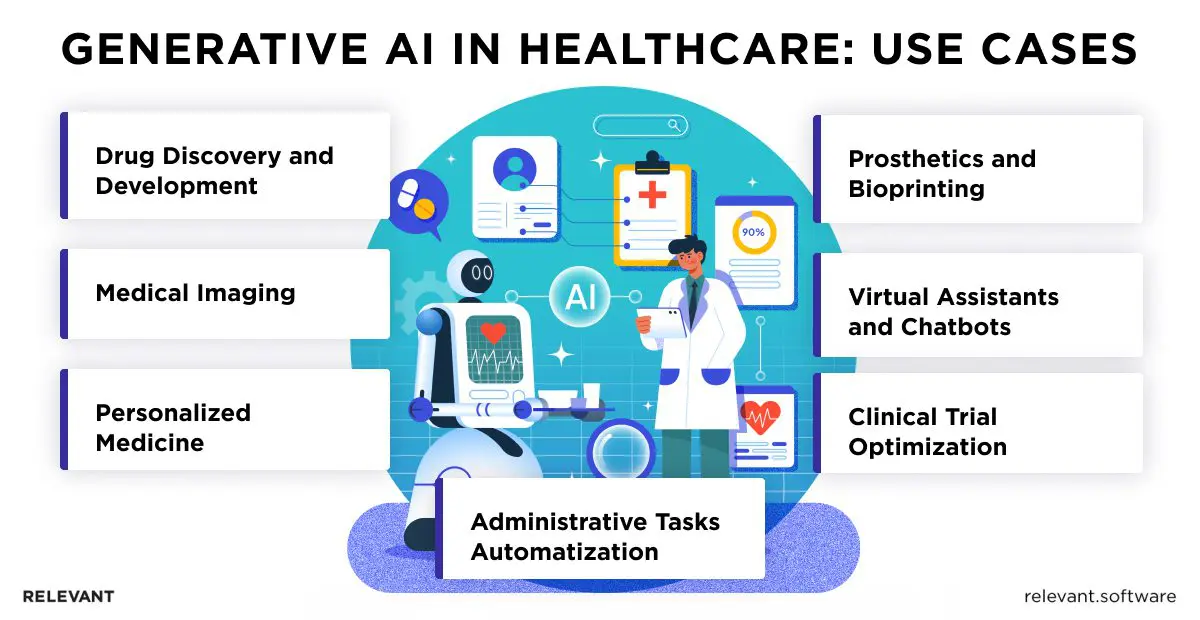
Drug Discovery and Development
Drug discovery acceleration is one of the notable AI in healthcare examples. The Congressional Budget Office reports that new drug creation usually costs between $1-2 billion, factoring in failed attempts.
Fortunately, AI can cut the time for designing and screening new drugs by nearly half, saving the pharma industry about $26 billion per year. Additionally, AI in healthcare companies can reduce clinical trial costs by $28 billion annually. Here’s how it’s being used:
- New Compounds Creation: Researchers can use generative AI healthcare to explore various chemical compounds quickly. The AI suggests new compounds with desired properties, which speeds up the search for potential drugs and identifies promising molecules for further development.
- Drug Interaction Insights: AI predicts the interactions between different drugs, which is critical for maintaining safety and effectiveness. This is vital for formulating combination therapies that boost treatment success and decrease risks.
- Biomarkers Identification: Generative AI can identify disease-related biomarkers, which helps to categorize patients based on individual characteristics. This leads to the development of more precise and effective targeted therapies.
- Clinical Trials Design: AI uses historical data from clinical trials to improve trial design, select the right patient groups, and anticipate potential challenges. This makes clinical trials more efficient and increases their success rates.
- Side Effect Anticipation: AI models predict potential drug side effects early in development, which facilitates proactive interventions and improves overall drug safety.
- Existing Drugs Repurposition: Generative AI can spot new uses for available medications, forecasting their effectiveness against different conditions. That speeds up the development of treatments by using drugs that already have known safety profiles.
Medical Imaging
Generative AI in healthcare companies impacts medical imaging in several ways:
- Image Synthesis: Generative models create realistic images of organs or tissues. These images are great for training medical professionals and patients to understand their conditions through clear visual representations.
- Automated Segmentation: Generative AI can automatically segment organs or abnormalities in medical images. This saves healthcare professionals a lot of time and makes the image analysis process more efficient.
- Pathology Prediction: By identifying patterns in medical images, generative AI anticipates or diagnoses pathological conditions. This promotes early detection and intervention, benefiting patient outcomes.
Personalized Medicine
How is AI used in healthcare to detect diseases early and provide personalized treatments? Here’s an overview of AI in healthcare examples for customizable care.
- Treatment Plans Customization: By reviewing patient data, such as genetic information and medical history, generative models create personalized treatment plans. This enables doctors to choose the most effective therapies and predict patient outcomes.
- Disease Progression Prediction: AI can build models to estimate disease progression and treatment efficacy by examining large datasets and various patient factors. That helps healthcare professionals make informed decisions and optimize care.
- Real-Time Decision Support: Generative AI offers clinicians immediate, evidence-based treatment recommendations tailored to a patient’s genetic profile. That speeds up decision-making by quickly analyzing vast amounts of data.
- Ethical and Legal Guidance: With AI’s support, doctors can more easily navigate the ethical and legal issues of personalized medicine. That ensures they adhere to privacy regulations and ethical standards, which builds patient trust and keeps them within the law.
- Efficiency in Genetic Testing: Generative AI optimizes workflows, handles routine tasks automatically, and boosts the efficiency of genetic testing processes. That is crucial for making personalized medicine more accessible despite resource limitations.
- Drug Prescription Optimization: AI reviews pharmacogenomic data to forecast how individuals will respond to medications, allowing doctors to tailor prescriptions to a patient’s genetic profile. That improves treatment outcomes and reduces adverse effects.
Prosthetics and Bioprinting
Prosthetics and bioprinting are among AI in healthcare examples. From custom limbs to the future of organ transplants, this technology has a profound and exciting impact, providing hope and new possibilities for those in need.
- Custom Prosthetics with AI: AI can design custom prosthetics that fit each patient’s unique anatomy. This means better comfort, improved functionality, and a more natural feel.
- Innovations in 3D Bioprinting: AI-driven 3D bioprinting arranges cells and biomaterials to form tissues that could replace damaged organs. This step moves us closer to personalized healthcare, eventually solving the shortage of donor organs and providing customized solutions for patients.
Virtual Assistants and Chatbots
Generative AI makes conversations more reliable, personalized, and efficient, which makes healthcare more accessible for everyone involved. Let’s explore the role of AI in healthcare for customer support.
- Always Available Help: Virtual assistants and AI chatbots in healthcare provide 24/7 support. Patients can ask questions, schedule appointments, and get medical advice any time of day. This constant availability means people get the needed help when required without waiting for office hours.
- Personalized Care: These smart AI tools can access a patient’s medical history and provide personalized responses. That ensures that the advice or information is relevant to the individual’s situation.
- Efficiency Boost: Virtual assistants and chatbots take care of routine tasks for healthcare providers, freeing up time for more complex duties. They manage patient inquiries, send appointment reminders, and assist with medication management, allowing healthcare professionals to focus on providing care.
For businesses interested in leveraging these benefits, consider exploring Conversational AI chatbot development services to enhance your healthcare support systems.
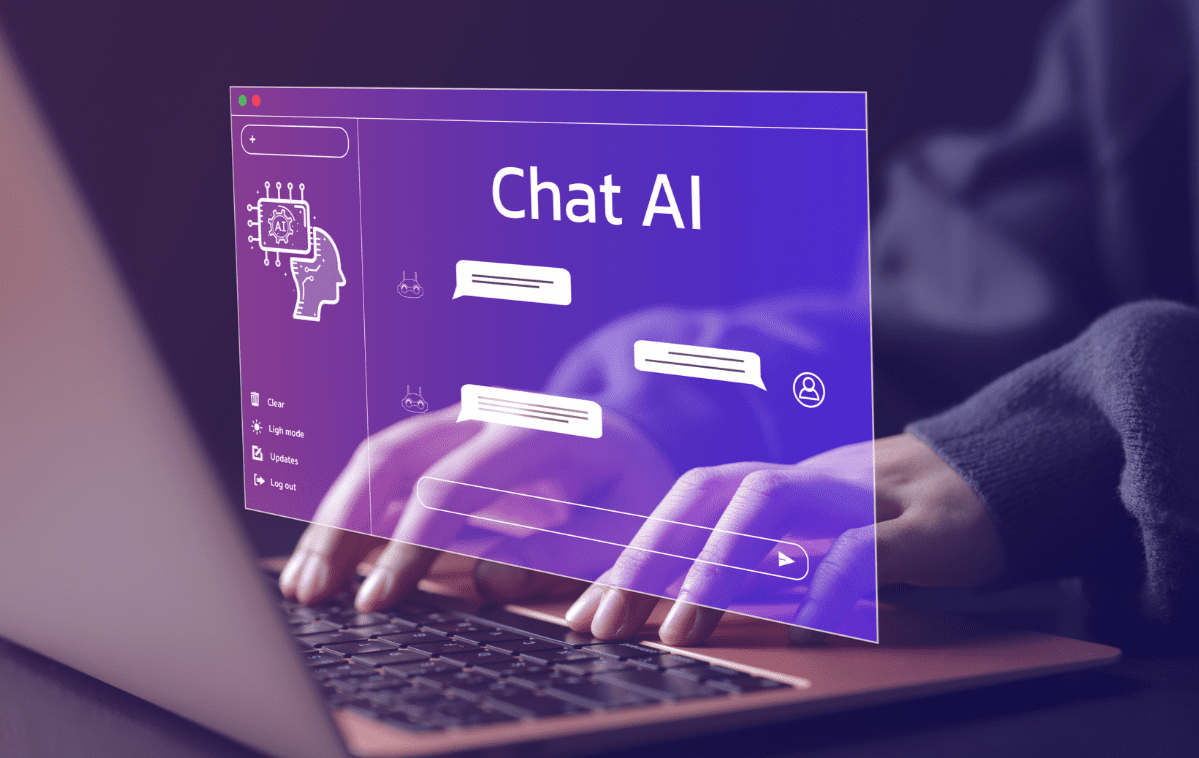
Clinical Trial Optimization
Streamlined clinical trials are significant AI in healthcare examples. Generative AI is reshaping how researchers conduct clinical trials, making them faster and more efficient by:
- Better Patient Selection: AI sifts through vast data to find the best candidates for clinical trials. What’s more, AI predictive analytics in healthcare improves matches between patients and trials, leading to more accurate results and higher success rates.
- Outcome Predictions: AI can predict potential outcomes based on past data and patient characteristics. This allows researchers to design better trials and foresee challenges, saving both time and resources.
- Streamlined Processes: AI handles many administrative tasks, which reduces the burden on researchers and speeds up the trial process. That allows scientists to focus on the critical parts of the study, ensuring trials run smoothly.
- Advanced Data Analysis: AI offers sophisticated tools for data analysis, which provide researchers with deeper insights and more accurate results. That improvement enhances decision-making and the quality of clinical research.
Administrative Tasks Automatization
With physician burnout rates in the US reaching 62%, there’s a pressing need to alleviate the load of doctors. Burned-out doctors are more likely to make errors, alcohol abuse, and even have suicidal thoughts.
Generative AI in healthcare use cases can help reduce this strain by handling administrative duties, which account for 15-30% of overall healthcare spending, according to HealthAffairs. Here’s how generative AI can assist:
- Data Extraction: AI can analyze patient medical records to extract relevant information and update health registries. It ensures that healthcare professionals have accurate and timely data for optimal patient care.
- Transcription and Documentation: AI can take notes during patient consultations, summarize the details, and add them to EHR as clinical documentation. It also generates structured health reports by analyzing patient data, which includes medical history, lab results, and scans. Moreover, AI can recommend customized treatment options.
- Assistance for Doctors: AI helps doctors by answering their queries and finding optimal time slots for appointments based on patient needs and doctor availability. It also creates personalized appointment reminders and follow-up emails.
- Insurance and Patient Feedback: AI reviews medical insurance claims, predicting which ones might be rejected. It also composes surveys to gather patient feedback, analyze the data, and provide actionable insights to improve care.
Ethical Considerations and Challenges of Generative AI in Healthcare
Even though tech giants and consulting firms continue to invest heavily in AI, prominent figures like Elon Musk and Sam Altman are sounding alarms about the risks associated with this technology. So, what challenges does generative AI bring to healthcare?
Bias
The effectiveness of AI models depends on the quality of the data on which they are trained. If this data does not fairly represent the target population, it can lead to bias against underrepresented groups. Generative AI tools, which train on vast amounts of patient data, can inherit these biases, which makes it difficult to detect and correct them.
Lack of Regulations
Despite AI’s significant ethical concerns, no official regulations currently govern its use. While the US and the EU are working on policies to address this, formal regulations are expected later.
Accuracy Concerns
AI, like any other technology, can make mistakes, but in healthcare, such errors can be costly. Large language models can generate plausible-sounding but factually incorrect outputs, a phenomenon known as “hallucination.” Healthcare organizations need to determine when errors are acceptable and when AI models must provide explanations. For instance, in cancer diagnosis, doctors are unlikely to use AI tools that cannot justify their recommendations.
Accountability
Determining who is responsible for health outcomes when AI is involved can be tricky. Is it the doctor, the AI vendor, the AI engineers or someone else? This lack of clear accountability can negatively impact the motivation and performance of AI in healthcare.
Cost
The development and implementation of generative AI systems are expensive. These costs include the technology and the necessary infrastructure, ongoing maintenance, and the need for specialized personnel. Smaller healthcare providers might find these costs prohibitive, potentially widening the gap between well-funded and less-resourced organizations.
While generative solutions have great potential, addressing these problems with AI in healthcare is mandatory for their deployment.
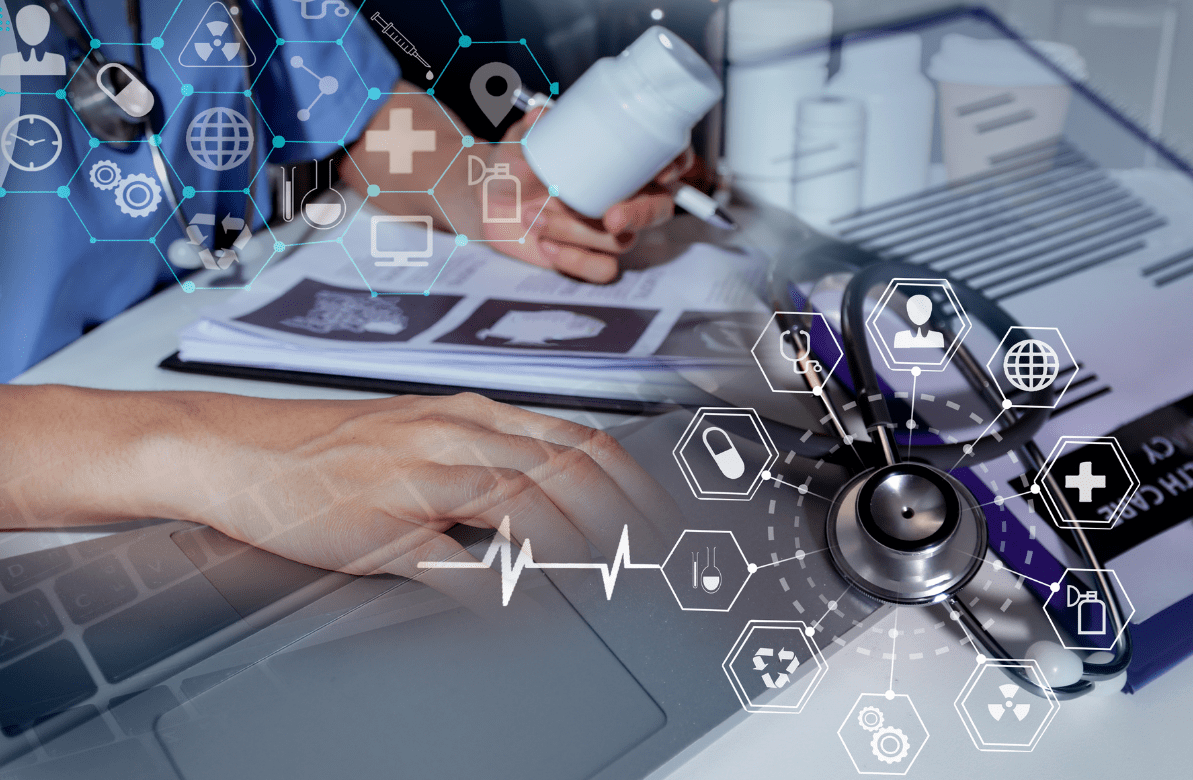
Generative AI in Healthcare: Bottomline
There are many entry points for you to start with Generative AI. The crucial part is to address the problem and desired outcome first and then think about the technology. But if you have yet decided to implement AI-based solutions, here are some tips to help you:
- Prepare Your Data: Even if you choose a pre-trained AI model, you might still need to retrain it with your proprietary data. Guarantee that your dataset is top-notch and reflective of the target population. Always protect medical data and uphold patient privacy. Disclosing the dataset used for training can reveal the algorithm’s strengths and areas for improvement.
- Take Control of Your AI Models: Promote a responsible AI framework within your team. Clearly communicate the proper usage of AI tools and establish who is responsible for the results. Test generative AI models on low-impact use cases before expanding to more critical applications. Recognize that AI can make mistakes, so determine where a small failure rate is acceptable and where it is not. For instance, 98% accuracy may be sufficient for administrative tasks but not for diagnostics. Establish a framework to govern the use of generative AI in your healthcare setting.
- Help Your Employees Embrace the Technology: AI still requires human oversight, especially in healthcare. Human-in-the-loop remains essential for AI success. Medical and administrative staff will need to supervise AI models, so training is crucial. Employees should learn to integrate AI into their routines, using the time saved to add more value.
- Find an Experienced Provider: Look for a provider with a proven track record in AI implementation to ensure a smooth integration process. If you turn to AI outsourcing, evaluate vendors’ portfolios of past projects to see how they have successfully implemented AI solutions in similar settings. Check their familiarity with regulatory compliance, such as HIPAA and GDPR.
Interested in generative AI but unsure of the next steps? Contact us! We’ll help you prepare your data, implement the generative AI tool, and integrate it smoothly into your internal processes.



